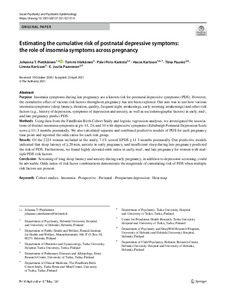Estimating the cumulative risk of postnatal depressive symptoms: the role of insomnia symptoms across pregnancy
Pietikäinen Johanna T.; Härkänen Tommi; Polo-Kantola Päivi; Karlsson Hasse; Paunio Tiina; Karlsson Linnea; Paavonen E. Juulia
Estimating the cumulative risk of postnatal depressive symptoms: the role of insomnia symptoms across pregnancy
Pietikäinen Johanna T.
Härkänen Tommi
Polo-Kantola Päivi
Karlsson Hasse
Paunio Tiina
Karlsson Linnea
Paavonen E. Juulia
SPRINGER HEIDELBERG
Julkaisun pysyvä osoite on:
https://urn.fi/URN:NBN:fi-fe2021093048781
https://urn.fi/URN:NBN:fi-fe2021093048781
Tiivistelmä
Purpose Insomnia symptoms during late pregnancy are a known risk for postnatal depressive symptoms (PDS). However, the cumulative effect of various risk factors throughout pregnancy has not been explored. Our aim was to test how various insomnia symptoms (sleep latency, duration, quality, frequent night awakenings, early morning awakenings) and other risk factors (e.g., history of depression, symptoms of depression and anxiety, as well as sociodemographic factors) in early, mid-, and late pregnancy predict PDS.
Methods Using data from the FinnBrain Birth Cohort Study and logistic regression analyses, we investigated the associations of distinct insomnia symptoms at gw 14, 24, and 34 with depressive symptoms (Edinburgh Postnatal Depression Scale score >= 11) 3 months postnatally. We also calculated separate and combined predictive models of PDS for each pregnancy time point and reported the odds ratios for each risk group.
Results Of the 2224 women included in the study, 7.1% scored EPDS >= 11 3 months postnatally. Our predictive models indicated that sleep latency of >= 20 min, anxiety in early pregnancy, and insufficient sleep during late pregnancy predicted the risk of PDS. Furthermore, we found highly elevated odds ratios in early, mid-, and late pregnancy for women with multiple PDS risk factors.
Conclusion Screening of long sleep latency and anxiety during early pregnancy, in addition to depression screening, could be advisable. Odds ratios of risk factor combinations demonstrate the magnitude of cumulating risk of PDS when multiple risk factors are present.
Kokoelmat
- Rinnakkaistallenteet [27094]
